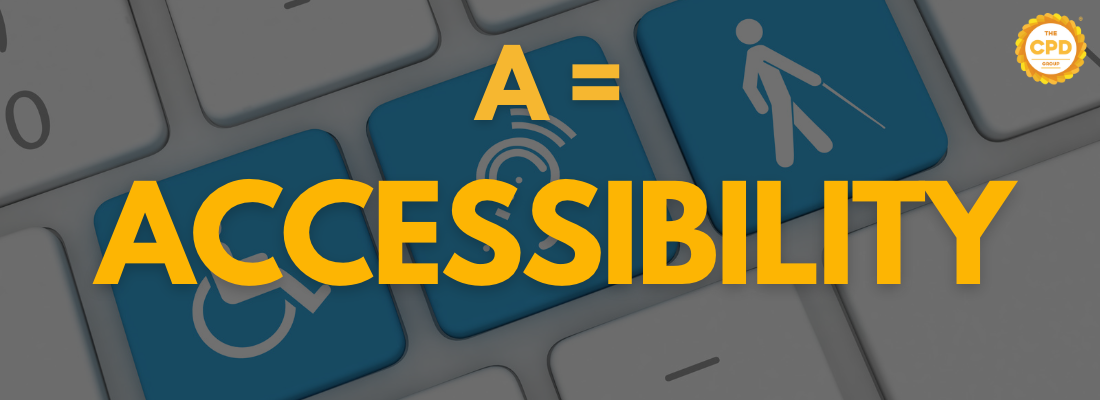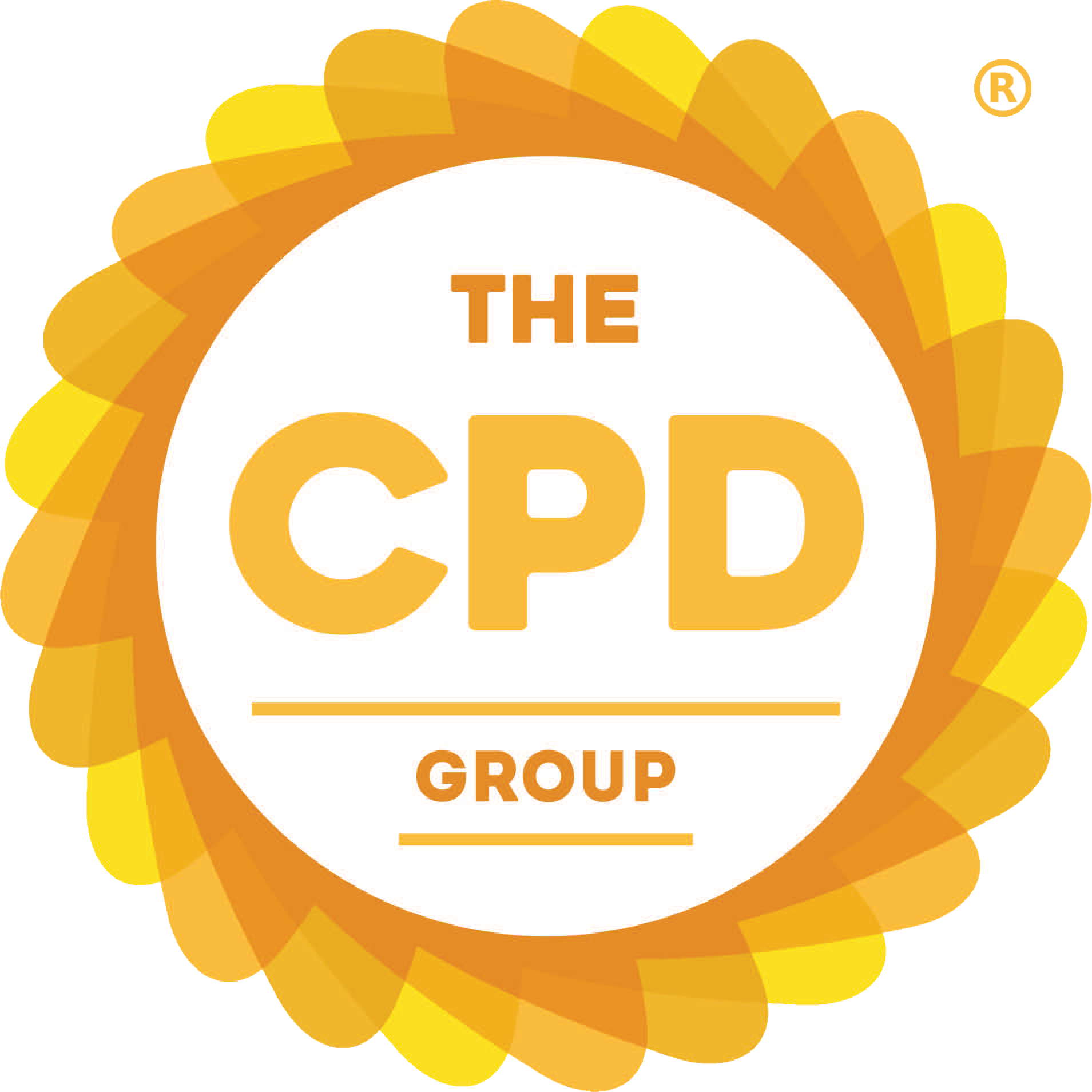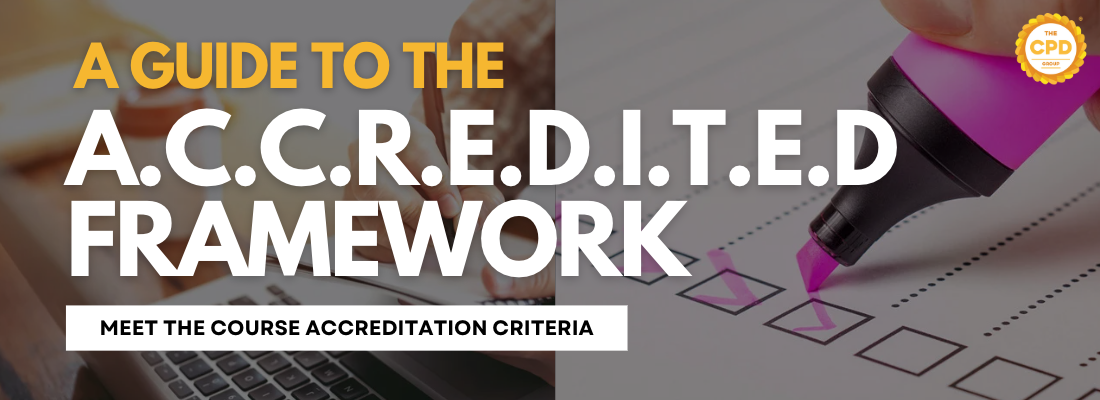What is the CPDA.C.C.R.E.D.I.T.E.DFramework and Why is it Important?
When submitting your CPD courses for accreditation, one of the most important things you can do to ensure your accreditation goes smoothly is to refer to our A.C.C.R.E.D.I.T.E.D Framework. This is the tool we use to make sure that your course is hitting all the criteria to be given that all important CPD accredited stamp of approval. It’s crucial to take it into account before submitting your courses for accreditation, as we will send it back to you if it doesn’t meet all the criteria, as we want to make sure every single course we accredit is of the highest standard.
It's a good idea to think of the A.C.C.R.E.D.I.T.E.D Frameworkas your reference guide when creating your courses. Measure your course against it regularly to ensure it is up to date with CPD standards and use it as a basis for any future courses you create.

Why is the Framework important?
The Framework is super important for everyone involved in CPD learning. It’s important for your learners, as it ensures the end recipient of the CPD course is receiving a learning experience that has been assessed from every angle. It’s important for you as it acts as a guideline for your courses and allows you to submit them to us with confidence they will be accredited. Finally, it’s an important benchmark for us to assess courses against that course we accredit has been thoroughly assessed for quality.
How to use the A.C.C.R.E.D.I.T.E.D Framework
To increase the chances of a smooth accreditation process, it is essential to take the A.C.C.R.E.D.I.T.E.D Framework into account when developing and submitting your CPD courses. Consider the following steps…
Review the Framework
Take some time to familiarise yourself with the criteria outlined in the framework and check that your course fully addresses each aspect. Put yourself in the learner’s shoes and ask yourself if they would be fully satisfied with the learning experience they receive.
Review Your Course
Ensure that your course aligns with each element of the Framework. Carefully work through each section of the Framework and measure your course materials against it, making any changes along the way before you submit it for accreditation.
Continuous Improvement
The A.C.C.R.E.D.I.T.E.D Framework isn’t just there to help your course get accredited, it’s there as a tool to help you maintain excellent standards and make course the best it can be for your learners. It’s important to regularly review and update your course for relevance, for example. Industry standards and knowledge are constantly being updated, so it's important to stay in the loop and review your course against the Framework regularly.
What is the Framework?
The A.C.C.R.E.D.I.T.E.D Framework consists of 10 different elements that we measure your course against to ensure it meets all the requirements of a top-quality course.
A = Accessibility
C = Content
C = Creative
R = Relevant
E = Eligibility
D = Details
I = Intellectual Property
T = Tested
E = Expertise
D = Duration

A for Accessibility
The CPD Group understands the importance of making courses available to all learners. As a result, accessibility is an essential component of the framework and is considered while evaluating your individual courses.
Are you mindful of those with disabilities and account for any struggles they might face which could affect the quality of their learning experience with you?
For example, we make sure your activity is accessible (or can be made accessible) to those who have visual impairments or are hard of hearing.

C for Content
Content is key. Our Accreditation and Compliance Team thoroughly check the content of your activity to ensure that the information you have provided is factually correct, relevant, and up to date.
It’s crucial that your learners are receiving accurate information if they are to have a purposeful learning experience. Ensure you are using legitimate and trustworthy sources when gathering content and referencing throughout.
C for Creative
It’s one thing to have great content. But it’s how you deliver this content that will make or break a learner’s experience!
The Accreditation and Compliance Team are looking to see how your courses are delivered to your learners and whether they are likely to remain engaged throughout.
Do you include various methods of content delivery such as video, group discussions, handouts? How do you get this information to stick with learners?

R for Relevant
Is the content within your training materials relevant to the subject? Do your handouts reflect the content that has been delivered throughout the session?
It’s important that your content is relevant and flows seamlessly throughout, this ensures that your learners are getting exactly what they expected upon purchasing your course.
We check to see whether the contents of your activity are relevant to what is advertised online and if these promotional materials are misleading in any way.

E for Eligibility
Ensuring that the right people are attracted to your offer is vital when promoting your courses.
Prerequisites are a way of making sure that students meet the eligibility criteria and enrol onto a course or subject with some prior knowledge. It might be that your activity has no prerequisites to enrolment, which is perfectly fine, but our Accreditation and Compliance Team will be interested to know if there are any.
If there are prerequisites, it is essential that this is clear from the start so that potential students can make the choice as to whether your activity is right for them. Will your students need to prove that they have met the prerequisite criteria? If so, how?
All good things to cover to ensure you are aiming at the right market and attracting the right people.

D for Details
The devil is in the details! The Accreditation and Compliance Team examines the smallest details to ensure your course is entirely accurate, easily understandable and adheres to professional writing standards.
Are you including up-to-date references where applicable? Are these references reliable, from a credible source? Is your spelling and grammar correct? If your learners are going to take your course seriously, they’ll expect to see well written sentences, correct punctuation, and fantastic grammar.
I for Intellectual Property
We cannot emphasise enough how important it is that you own or are licensed to use the materials you are offering.
The Accreditation and Compliance Team check that the content has been truthfully and legitimately produced, looking out for clear indications of plagiarised content. Where you have been given permissions to use other’s work, we will ask to see evidence of this.
If you’re not sure about the rules of Intellectual Property, we have some handy information to clarify this under “Resources” in your CPD account. Log in here!

T for Tested
An effective activity will contain some form of assessment that enables the learner to solidify the knowledge they have gained and validate their progress.
This also gives a good opportunity for you to analyse the results to understand where learners are under performing. If there is a theme, you can review your delivery and monitor whether this affects future results.

E for Expertise
An excellent activity will benefit from its creator being fully clued up on their specialist subject.
The Accreditation and Compliance Team will always check that the author of the course possesses the relevant knowledge and experience to create the course effectively.
For example, you wouldn’t want to be taught to drive by someone who has never driven - we’d need evidence that you’ve been in the driver's seat!

D for Duration
After our Accreditation and Compliance Team assess your courses, and prior to them being submitted to The CPD Register, our Assessors will assign a number of CPD Credits to the activity to help people record their ongoing CPD.
CPD Credits are worked out as 1 hour of study = 1 CPD Credit so establishing the correct number of hours, on average, students take to complete the activity, including any ‘Home Study’, is vital to ensure the correct number of CPD Credits are allocated to each individual activity.
This helps employers set and monitor CPD targets, while offering individuals a clear way of evidencing their ongoing development.
The A.C.C.R.E.D.I.T.E.D Framework: A Valuable Tool for CPD Course Creation
As you can see, the Framework covers every aspect of your course – from its content to the way you test learners, to the expertise of the author of the course. The Framework is an essential tool for anyone considering creating a CPD course in any industry, as it helps you cover all bases and adhere to every learner’s needs.
If you have any further questions regarding our course Framework, please don’t hesitate to get in touch with our Accreditation and Compliance Team!




Discussion (0)
Join the conversation and share your insights with our community
Join Our Community
Share your expertise, ask questions, and engage with fellow CPD professionals
Start the Conversation
Be the first to share your thoughts on this article. Your insights could help other professionals in their CPD journey.